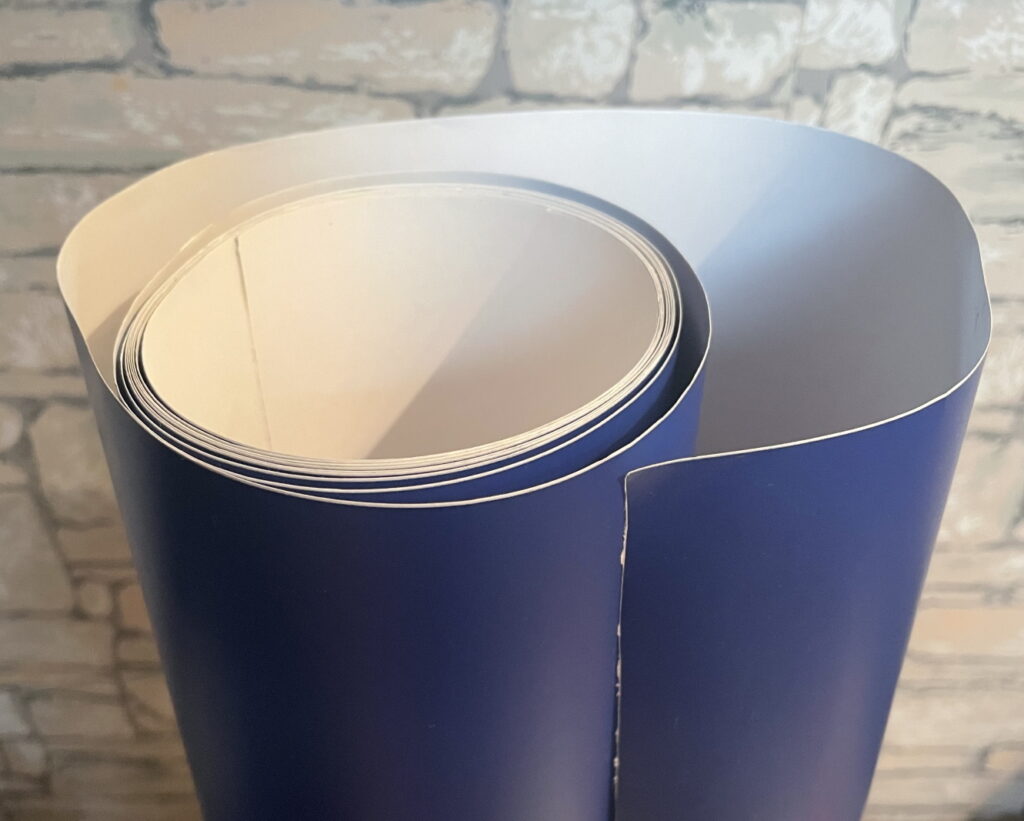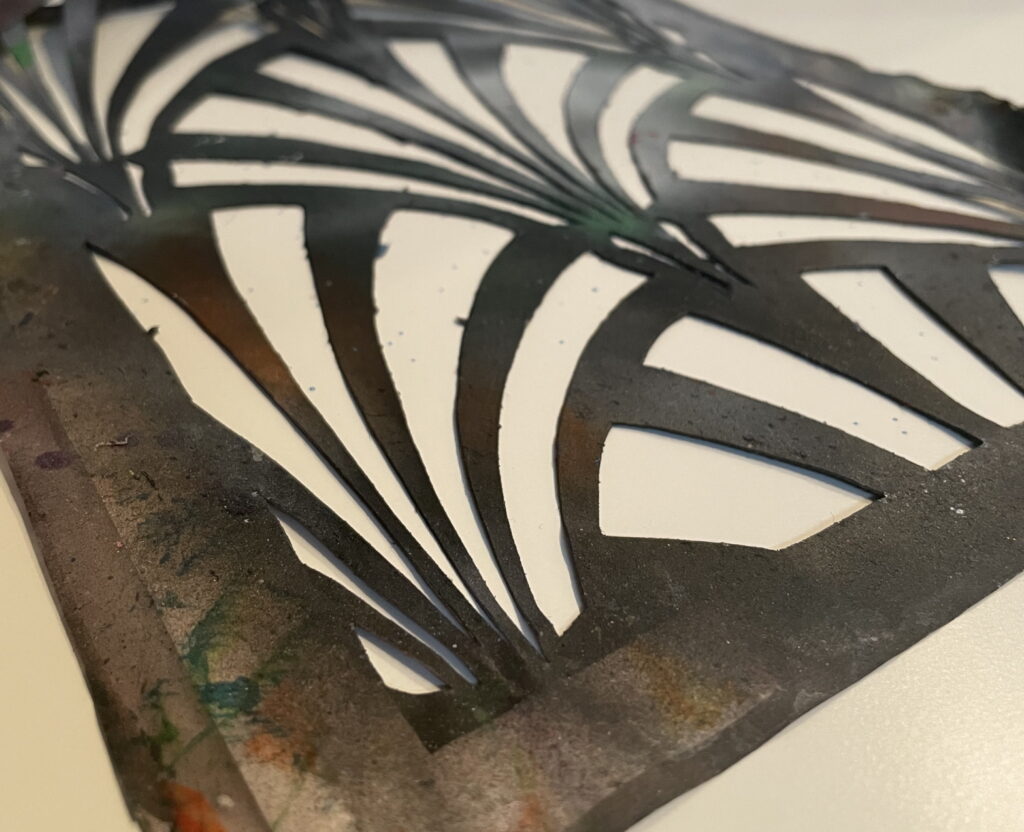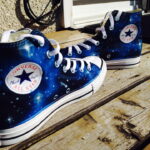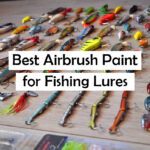Airbrush stencils are amazing time savers that allow you to paint some incredible designs with an airbrush.
As someone that has worked in body painting and airbrushing for years, I’ve spent way too much time and money making intricate stencil patterns only to have them fall apart. Take it from me that making stencils out of the right materials in the first place will save you headaches in the long run.
The best material for airbrush stencils is Mylar. Mylar is a polyester film that’s durable, flexible, and moisture proof – making it reusable. It can be used for hand made stencils or cut using a stencil machine. Mylar for airbrush stencils typically comes in a range of thicknesses from 1 mil to 10 mil.
Generally speaking, your going to have three different types of airbrush stencils:
- Adhesive airbrush stencils
- Reusable airbrush stencils
- Handmade airbrush stencils
Mylar works great for any of these three types of airbrush stencils and especially for reusables. But there are some other great options for airbrush stencil material if mylar doesn’t quite meet your needs.
If that’s the case, read on because this article is for you.
So what makes good material for airbrush stencils anyway?

What makes great airbrush stencil material
The characteristics of great stencil material are as follows:
- Its water resistant
- It’s durable
- It’s flexible
- Its carvable
Water resistance is important for the obvious reason that when you spray it with airbrush paint, it won’t distort, melt and ultimately dissolve before your eyes. Even if you don’t plan on reusing it, a stencil should be able to hold up at least until the job is complete.
Durability is very important for handling and making reusable stencils last. One of the worst feelings is to spend ages on a perfect stencil design only to have it fall apart.
Flexibility gives your stencil collection versatility. Rigid materials might work for flat canvas artwork. But if the inspiration strikes you to one day paint shoes or get into body painting, a flexible stencil will work 100 times better.
What I mean by carvable is that designs should be as intricate and exact as possible within the cutting material.
The more exact and precise your cuts are, the “tighter” your airbrush work will be.
Something like a big piece of perforated cardboard would certainly check the durable category, but it would be extremely uncarvable because of its thickness and coarseness.
Best material for adhesive airbrush stencils

The best material for adhesive stencils is craft vinyl. Craft vinyl is made from polyvinyl chloride (PVC) – a highly versatile plastic that is found in many products. It checks all the boxes of great material for adhesive airbrush stencils.
| Vinyl PVC Stencil Material | |
| Water Resistance | 9/10 |
| Durability | 7/10 |
| Flexibility | 10/10 |
| Carvability | 9/10 |
Generally, craft vinyl comes in a roll with a thin PVC plastic layer stuck to a temporary paper backing. Once the design is cut into the plastic layer, the paper backing is removed, revealing the adhesive side. Simply apply the vinyl design to any surface that you want, airbrush the design outline, and then remove it when you’re done.
Craft vinyl works best with a stencil cutting machine. The roll fits directly into the machine and cuts a computer generated design directly into the vinyl. The blade is designed to cut deep enough to cut through the vinyl but not pass through the paper – leaving an easily transferable design on a solid sheet.
Unfortunately, craft vinyl is not made for hand cutting. So if you’re looking to use this method to cut a ton of adhesive airbrush stencils, you’ll have to get a stencil cutting machine.
Check-out this article that reviews the best stencil cutting machines for airbrush stencils.
Best material for reusable airbrush stencils

Mylar is the best material for reusable airbrush stencils. Mylar is the most versatile material for airbrush stencils because it can be cut by hand or with a machine, and it meets all the criteria for a good stencil cutting material.
| Mylar Stencil Material | |
| Water Resistance | 10/10 |
| Durability | 10/10 |
| Flexibility | 9/10 |
| Carvability | 9/10 |
Mylar is the brand name for a DuPont developed polyester film. It’s basically a flexible plastic sheet that comes in various thicknesses and sizes.
It’s similar to vinyl in that it’s a flexible, water-proof plastic, but different in that it’s not adhesive backed and is therefore reusable.
You can cut mylar on a stencil cutting machine, or you can cut out designs by hand using a soldering tool.
Mylar usually comes in 12’ x 12’ sheets of various thicknesses. Good stencil cutting machines can handle mylar between 1 mil and 10 mil (1 mil being the thinnest and 10 mil being the thickest). The thickness of mylar in this range is up to your personal preference depending on how flexible you want your airbrush stencils to be.
All in all, mylar is probably the most ideal material for airbrush stencils, so if you want to make a ton of high quality reusable stencils for your artwork. Just get a stencil cutting machine and a ton of mylar sheets.
Best material for handmade airbrush stencils

If you don’t have a stencil cutter machine, you are going to have to cut stencils out by hand. You can do this using mylar and a soldering tool, or you can use the frisket film over paper method.
Frisket film is a flexible plastic that’s kind of like vinyl in that it comes on an adhesive roll. Although it is a little bit coarser, see-through, and not made to be cut with a vinyl/stencil cutter.
You can also get it at your local department store and don’t have to go to a specialty craft store to find it.
| Frisket Film and Paper Stencil Material | |
| Water Resistance | 7/10 |
| Durability | 8/10 |
| Flexibility | 7/10 |
| Carvability | 8/10 |
The frisket film method involves:
- printing or drawing your stencil design on paper first. Then,
- you peel the frisket film off of the adhesive backing and cover both sides of the paper.
- Using an exacto knife, cut through the three layered sandwich of frisket film and paper following the design outline.
In the end, you should have a water resistant, durable airbrush stencil that can be used again and again. Eventually, water will start to seep into the cracks between the frisket film and paper. It will deteriorate over time, but it should last you for dozens of uses if you take care of it.
The life of your handmade stencils can be prolonged by wiping and drying them after use.
When designing airbrush stencils, using the right material will determine the quality of the finished product. Whether you’re making adhesive, reusable, or handmade stencils, keep in mind which material will be best for the task at hand.
Mylar is the best and most versatile material for airbrush stencils, but that doesn’t mean there aren’t other options better suited to your purpose. Water resistance, durability, flexibility, and carvability are all important characteristics to consider when picking your airbrush stencil material.
Remember, you don’t have to marry yourself to one material or method. I started out making handmade stencils and eventually moved on to using a stencil cutting machine. Then I started using vinyl and eventually found that mylar worked the best.
At the end of the day, keep your artwork fun and fresh – never stop experimenting and continue to find creative ways to make your artwork unique.



